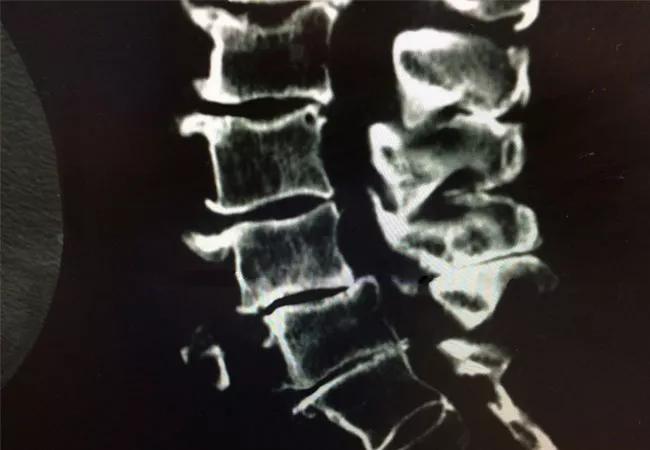With persistence, an elusive clinical challenge is consistently tackled

To the nonspecialist, the idea of a wrong-level spinal surgery — i.e., performing a spinal procedure at a location that was not originally intended — can seem almost like a joke: You’re a neurosurgeon. How hard is it to count the number of vertebrae to figure out where to operate?
Advertisement
Cleveland Clinic is a non-profit academic medical center. Advertising on our site helps support our mission. We do not endorse non-Cleveland Clinic products or services. Policy
In reality, wrong-level spinal procedures are a challenge that the spine care community, major institutions and individual spine surgeons have been struggling to overcome for years. Cleveland Clinic is among that group, but recently its clinicians evolved their protocol for avoiding these events to a point where they have gone nearly three years and approximately 10,000 spinal surgeries without a single wrong-level procedure.
The Cleveland Clinic experience in developing the protocol — a careful stepwise process based on case reviews and systematic changes — is detailed in a recent comprehensive narrative review in Spine (2021;46:E648-E654). It is the first description of a single institution’s serial root cause analysis of wrong-level spinal surgery cases and the resulting impact on interventions.
“We used a trial-and-error process that was essential to identifying gaps in our standard practice,” says corresponding author Ajit Krishnaney, MD, a spine surgeon in Cleveland Clinic’s Center for Spine Health. “The goal of sharing our method in detail is to expedite the process for other health systems aiming to improve their operations.”
Although wrong-level spinal surgery is considered a “never event” (i.e., a clearly identifiable and preventable medical error with serious consequences), most spine surgeons in surveys admit to having performed a wrong-level spinal procedure at least once in their career. Nevertheless, no evidence-based protocol to prevent wrong-level spinal surgery has been available, and the method of localization is usually left to surgeon discretion, particularly in private practice.
Advertisement
“The problem is that when you expose the spine at almost any level, except at the very top or very bottom of the spinal column, the vertebrae look essentially the same,” explains Dr. Krishnaney, who also serves as Cleveland Clinic’s Associate Chief Clinical Risk Officer. “With additional factors such as obesity, scoliosis and anatomic anomalies, the stage is set for error.”
Cleveland Clinic surgeons began examining the problem in 2008. Over the next decade, 14 wrong-level spinal surgeries occurred, and 13 corresponding root-cause analyses were conducted. Over the years, the following steps were added to standard operating procedures:
Later in 2018, the latter protocol was changed to include real-time verification of the correct position by a remotely located radiologist who reviews the intraoperative radiograph with retractors in place and fixed marker attached. This verification is done via phone and secure video chat during a two- to five-minute time-out.
Advertisement
Notably, no wrong-level errors have occurred since this latest protocol was implemented in October 2018.
The final but critical step of adding a radiologist to the review process was particularly difficult to implement, Dr. Krishnaney explains. Instituting it required upgrading radiology equipment to enable receipt of real-time imaging via Wi-Fi. All technicians were trained in uploading images to the radiologist, and radiologists were brought up to speed in reading intraoperative radiographs. A system was put in place to enable access to trained radiologists at all times.
“Consulting with a radiologist, who is away from the pressures and distractions of the operating room and has the equipment to enhance the images, makes for better outcomes,” says Dr. Krishnaney. “This method and its strict enforcement are unique to our institution and I believe are absolutely critical to the success we’ve achieved since it was implemented.”
According to Dr. Krishnaney, a small percentage of cases do not require the rigorous protocol. These include the following situations:
Minimally invasive procedures also do not use this protocol, as a solid marker cannot be permanently affixed to the spine. Likewise, percutaneous surgeries have a separate protocol that does not include a radiologist.
Advertisement
Initially the current protocol added 25 minutes to a case as staff figured out the technical details. Now that the process has been streamlined, radiologist verification is almost always completed in less than 10 minutes — often under five minutes.
Other than improving quality of care, Dr. Krishnaney adds that a big advantage of the protocol is that surgeons feel reduced pressure. “No one wants to make this kind of mistake,” he says. “It’s a big relief to know that in the rare circumstance in which one is at the wrong level, someone will catch it before the operation proceeds.”
Advertisement
Advertisement

Tool helps patients understand when to ask for help

Large NIH-funded investigation is exploring this understudied phenomenon

Advances in genomics, spinal fluid analysis, wearable-based patient monitoring and more

Case study of radial-to-axillary nerve transfer for tumor-related deltoid nerve injury

An update on the technology from the busiest Gamma Knife center in the Americas

Real-time adjustments may help reduce bothersome dyskinesias

Anatomical modeling can identify optimal surgical candidates, study suggests

Add AI to the list of tools expected to advance care for pain patients